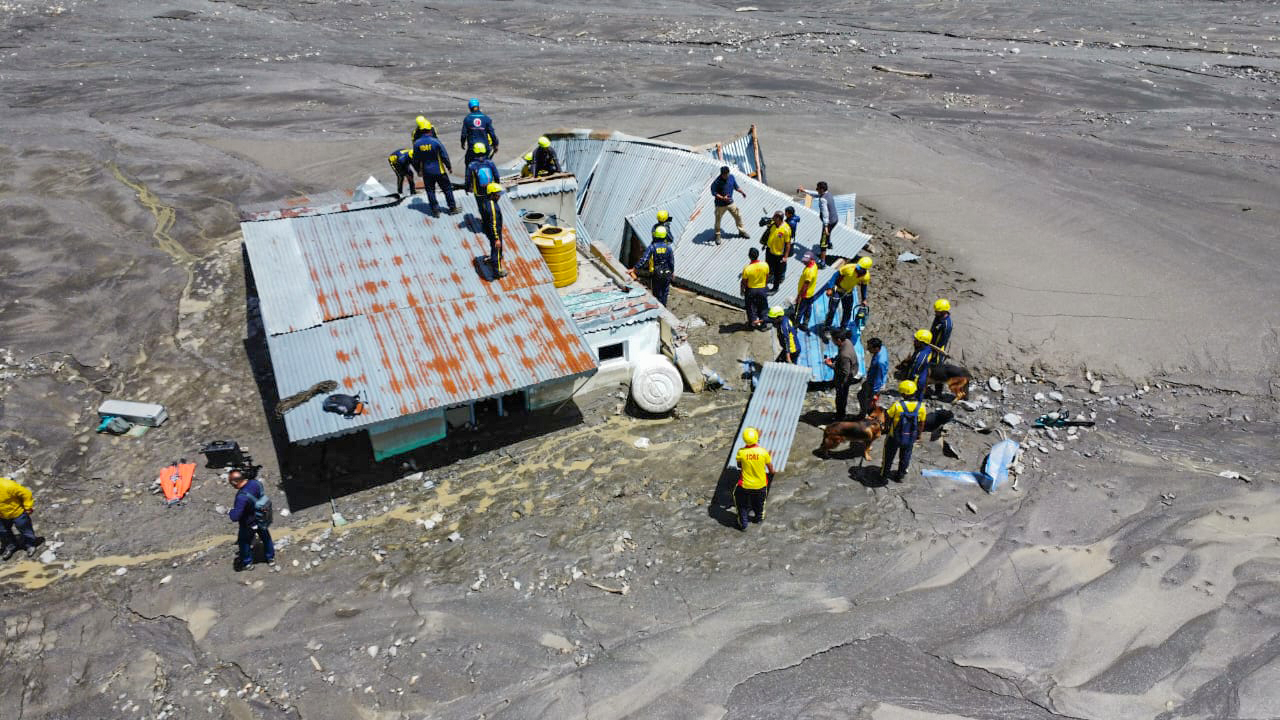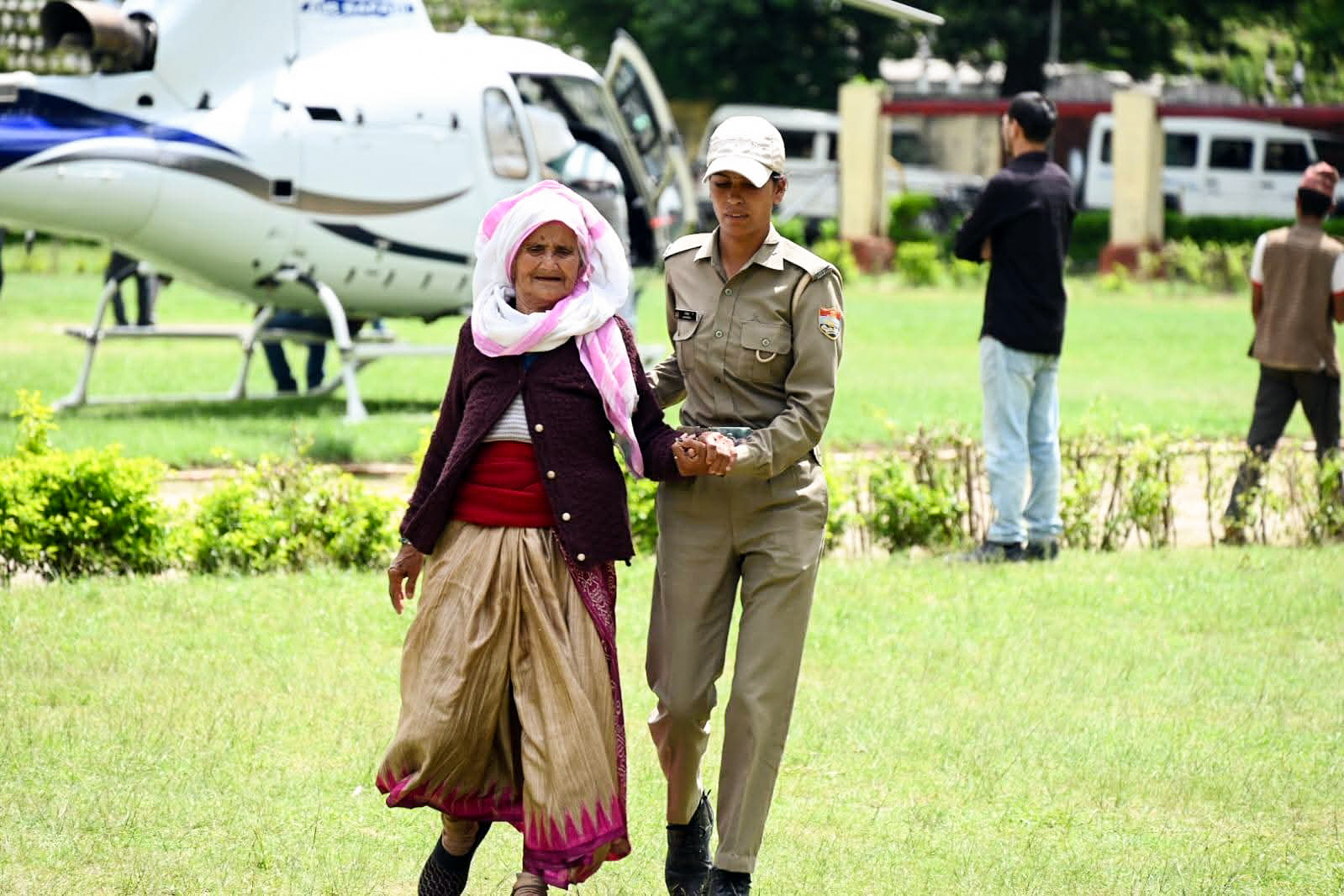
Mahmood Hassan
The climate disaster in the village of Dharali in Uttarakhand has created ripples across the country. A video on social media captured the entire trail of destruction as a small brook turned into a water bomb, submerging the village in mud and slush up to 40 to 60 feet within a few seconds.
People living in the higher elevations in the village of Mukhba had tried to warn the Dharali inhabitants of the gushing flash floods, but it was too late. In a preliminary survey, geologists reported that landslide-induced lake outburst triggered a chain reaction in several lakes upstream of the Kheerganga. The report was prepared in consultation with the scientists of the Indian Space Research Organization (ISRO).
The glacial-induced lakes formed in the mountain ranges become overloaded with a high volume of water due to the fast melting of snow. This results in constant small-level glacial lake outburst floods (GLOF).
 Rescue operation at village Dharali
Rescue operation at village Dharali
situated at 2700 metres above sea level, had been built on the dried course of the river Kheerganga. An army camp on the riverbed was also washed away, resulting in deaths.
Construction activities during the last two decades have compounded the impact of annual floods. The proposed National Highway No. 34 in a section of the Bhagirathi eco-sensitive zone along the Dharali village could lead to felling of more than 6000 deodar (Himalayan Cedar) trees and thus raise the risk of landslides.
Experts warn that felling of the trees may further destabilize the slopes and increase the risk of landslides. The unregulated construction of houses, hotels, and shops in the past two decades along the stream with a huge footfall of pilgrims to the Gangotri is taking a heavy toll on the eco-sensitive region.
Traditionally, the houses were built on the stable slopes. The flooding of the interlinked rivers Dhauliganga, Rishiganga, and Alaknanda in Uttarakhand has caused widespread damage.
Uttarkashi has been facing natural disasters for a long period. In 1991, an earthquake killed 768 people; in 1998, the Malpa landslide killed 221 people, the 1999 Chamoli earthquake took 103 lives, whereas the toll in the Kedarnath flash floods, also called “Himalayan Tsunami” in 2013, took a toll of 5700 lives. Despite this bleak scenario, no lessons were learnt by the state. Constructions continue unabated without following the path of sustainable development.
 A woman being evacuated from Village Dharali
A woman being evacuated from Village Dharali
After the Kedarnath disaster, the Supreme Court asked the Union Environment Ministry to study and make recommendations on the factors behind natural disasters. The Ministry set up a committee led by Ravi Chopra, the founder and Director of the People’s Science Institute, Dehradun, for this.
The committee recommended an overhaul of the environmental clearance procedure for projects.
The cumulative impact of projects as dams, tunnels, blasting, power houses, mining, deforestation, etc., has created an adverse impact on the fragile ecosystem. The region falls in the Seismic Zone No.5, which has a high risk of earthquakes. Yet the government is moving ahead with the construction of infrastructure, including a rail project. The other projects in the pipeline are the mega Char Dham Pariyojana, a mega project planned for road widening to connect major pilgrimage centres and the railway network in the state. The disaster at the Silkyara tunnel is one of many instances of such disasters.
The National Green Tribunal has raised serious issues over the mega projects in a fragile, ecologically sensitive region. After the 2013 floods, the state government imposed a ban on construction along the river banks. However, violations continued with the construction of several large infrastructure projects, such as hydropower and national highways. Now, after this disaster, the Uttarakhand government has banned construction near water bodies.
 Dharali village after the disaster
Dharali village after the disaster
There are already 14 dams over the 195-km Alaknanda River flowing through the state, and more than 53 are in the pipeline. The Rishiganga project was destroyed in the recent disaster. The power generated by these projects is meant for sale to Uttar Pradesh and Haryana. The Uttarakhand government has already contracted private parties for power generation and its sale. All this was done with utter disregard for the environmental fallout.
Dam constructions without proper environmental impact assessment have also been planned across the rivers in the northeastern region. These must be reviewed in the light of the recurring calamities like tone witnessed in Dharali.
Conservation and preservation of the rich biodiversity is the need of the hour. Loss of biodiversity may lead to water scarcity and fluctuating weather patterns. We can learn a great deal from our neighbour,
Bhutan.
The kingdom is conserving 71 percent of the forests, and dams built in the country were done through sustainable development. Intergovernmental Panel on Climate Change, in its report in 2019, said that glaciers would retreat in the coming years, causing more landslides and floods. Rapid melting of glaciers and ice caps forms lakes at the mouth or snout of the glaciers. These lakes or reservoirs suddenly get breached due to pressure, causing death and destruction in the river basins.
ALSO READ: Islam will vanish is not Hindu thought: RSS Chief Bhagwat
Such a disaster should serve as a valuable lesson for our policymakers who are going ahead with mega infrastructural projects in the region, which are likely to leave a trail of destruction in view of global warming and climate change. Sustainable development is the only alternative option for the economic development of a region, whether it is Uttarakhand or Arunachal Pradesh.
The author is an IAS officer posted in Assam government
